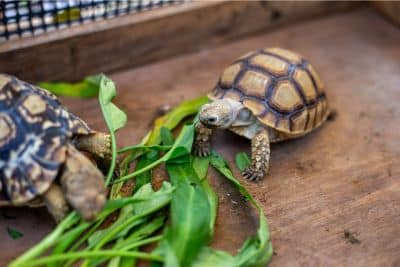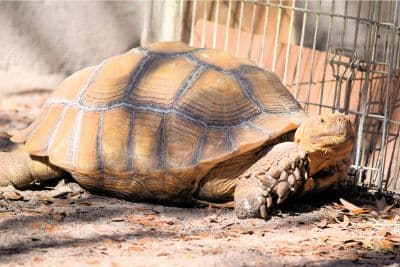As large tortoises, sulcatas (Centrochelys sulcata) require expansive enclosures, and because most keepers lack sufficient indoor space to accommodate these super-sized pets, they typically choose to maintain these gigantic chelonians outside. This not only makes it easier to provide your pet with ample room, but it also alleviates the need for expensive and elaborate lighting systems.
It’s still important to take care when establishing an outdoor sulcata enclosure. This will ensure that your pet’s needs are met and that he remains safe. In this article, I’ll explain exactly how to set up the ideal outdoor sulcata tortoise enclosure to meet all of your giant-sized pet’s needs.
Understanding Sulcata Tortoises
Before discussing the best way to set up an outdoor sulcata tortoise enclosure, it’s important to familiarize yourself with some of the basic facts about the species and its natural habitat.
Sulcata Tortoises: Size and Behavior
Sulcatas are fairly small when they hatch – most measure less than 2 inches in length and weigh about 1.5 ounces. However, they grow very quickly, and can reach lengths of 10 inches or more by 3 to 5 years of age. Eventually, most sulcatas will reach 20 to 30 inches in length and weigh 150 pounds or more (exceptionally large individuals may tip the scales at nearly 270 pounds).
Wild sulcatas construct large burrow systems, potentially reaching 10 feet or more in length. They’ll generally sleep inside these burrows at night, and then emerge in the morning to bask. They’ll often retreat into the burrows during the midday heat, but they may venture back out in the late afternoon, as the temperatures fall.
Natural Habitat Overview
Sulcatas inhabit a broad swath of land called the Sahel. It’s located immediately south of the Sahara Desert, stretching across the African continent from the Atlantic Ocean to the Red Sea. This region is characterized by a very hot and dry climate.
Permanent water sources are rare in the Sahel; so, sulcatas tend to congregate near temporary rivers and streams, when they’re available. Unfortunately, much of the natural range of these tortoises is under threat from human development and pollution.
Essential Elements of a Sulcata Habitat
Equipped with a basic understanding of sulcata tortoises and their wild habits, you can begin establishing an outdoor habitat for your pet. As follows:
Space Requirements
As a general rule, tortoises require a habitat that is as wide and long as their shell length in inches, multiplied by six or seven. In other words, if you have a 12-inch-long tortoise, he’d need an enclosure measuring an absolute minimum of 72-inches-by-72-inches. Most experienced keepers would, however, rightly argue that accommodations twice or thrice this size would be preferable.
Additionally, it’s important to note that your sulcata will exceed 12 inches in length over time. So, it simply makes the most sense to go ahead and consider his mature size when establishing the habitat.
This means that you’ll need to set aside at least 150 square feet for your tortoise, though 300 to 500 square feet would be ideal.
Materials for the Enclosure
There are a variety of different materials that can be used for an outdoor sulcata enclosure, and many keepers find that a combination of materials works best.
For example, many keepers like to establish a framework made from poured cement, bricks, or cinder blocks, and then add a sheetlike material (either plywood, plastic, or metal) around the inside perimeter to provide a smooth surface. Other keepers like to set up a PVC or wooden frame to which plywood, plastic, or metal sheets can be attached.
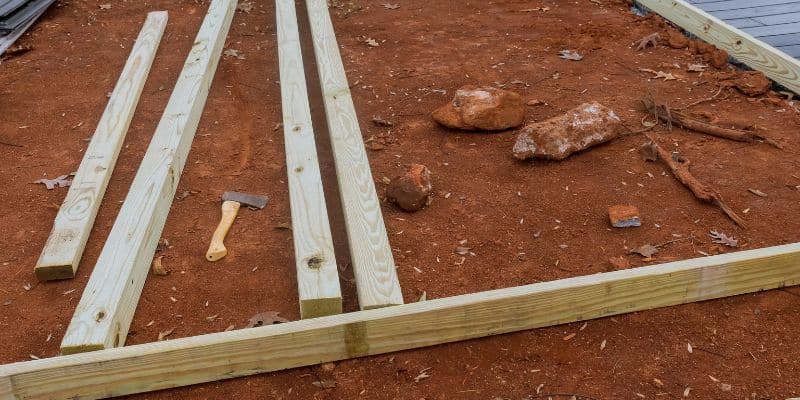
No matter which material or materials you decide to use, you’ll need to make sure that the enclosure walls penetrate at least 1 foot below ground level (and preferably farther). This will help dissuade your tortoise from tunneling below the enclosure walls and escaping.
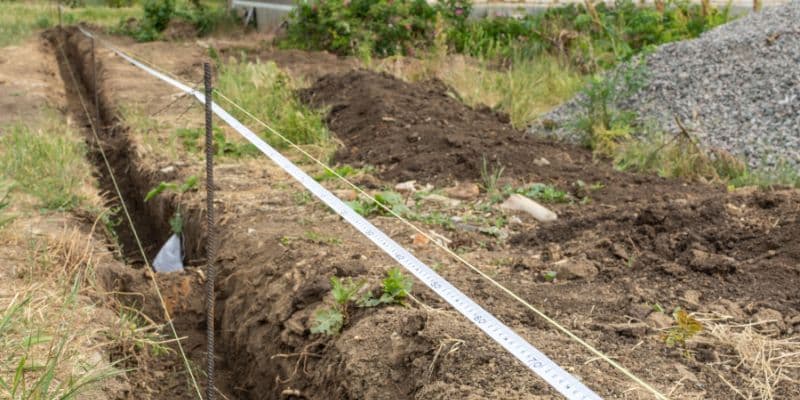
Because sulcata tortoises require such large enclosures, it’s often best to simply use the existing ground rather than adding any bedding or substrate. The soil should be well-drained and capable of supporting burrowing behavior.
One of the important benefits of outdoor sulcata enclosures is that you can maintain live grass and weeds in the enclosure, on which your pets will feed. Just be sure to stick to non-toxic varieties (such as Bermuda grass or clover) and understand that you’ll likely need to replenish the vegetation periodically.
Nevertheless, you can use a tortoise-safe mulch if you’d prefer.
Are You Starving Your Tortoise?
Save 10% on premium tortoise food and supplements from Tortoise Resource Center on Amazon now using code BUYNOWGET10
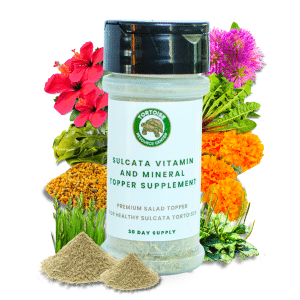
Sulcata Vitamin & Mineral Topper Supplement
30-Day Supply | 2 oz (56 g)
$24.99
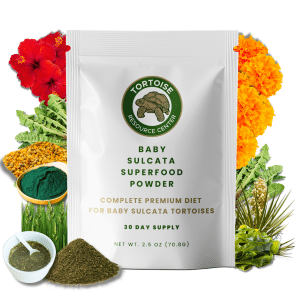
Baby Sulcata Tortoise Superfood Powder
30-Day Supply | 2.5 oz (70.8 g) Bag
$24.99
Environmental Conditions
Maintaining proper environmental conditions in an outdoor environment is easier than doing so indoors in some ways and more difficult in others.
On the one hand, there’s not much you can do to increase the temperature, alter the humidity, or prevent inclement weather. But on the other hand, you don’t have to worry about providing full-spectrum lighting, as the sun will do this for you.
Ultimately, success comes down to proper planning and enclosure design. For example, you’ll want to ensure that the enclosure receives ample sun exposure over the course of the day to allow your pet to bask and raise his body temperature. Just be sure that your tortoise has plenty of shaded places he can retreat to if the temperatures climb too high.
Note that while occasional rain showers won’t harm your tortoise (as long as the temperatures are warm), it is important that the overall enclosure isn’t allowed to become damp. This will largely depend on the characteristics of your soil (sandy soils will drain quickly; clay-rich soils will drain slowly), and you may find it necessary to install a French drain if the area frequently becomes saturated.
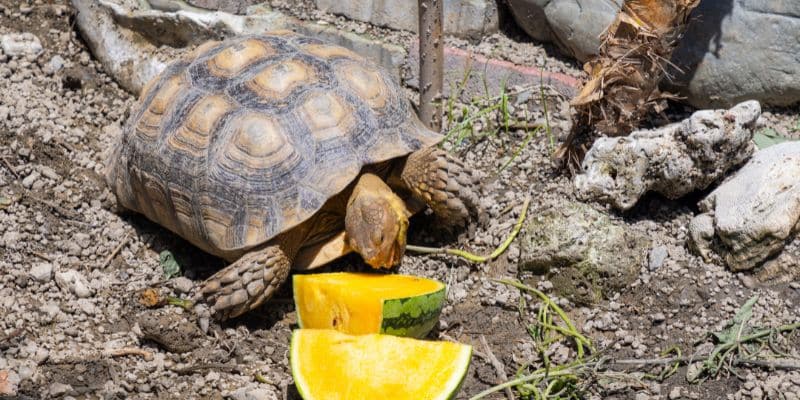
Providing proper care for a sulcata tortoise also means ensuring that your pet has plenty of things to investigate, explore, and interact with in his habitat – you don’t want him to live in an empty enclosure. This is not only important for his mental health, but it will also help prevent antagonistic interactions in enclosures housing more than one individual (though it may not prevent them entirely).
Some of the best items to include in an outdoor sulcata enclosure include:
- Large rocks
- Large cement blocks
- Large plant pots or plastic storage containers, half-buried on their side (to create small “caves”)
- Live, non-toxic plants and trees
- Large logs or pieces of driftwood
It is also imperative that you provide your sulcata with at least one (and preferably several) hiding spots. These will not only help to provide a sense of security, but they’ll also allow him to remain warmer at night, take shelter during inclement weather, and escape the sun when temperatures climb during the day.
Some keepers like to provide heated enclosures to outdoor enclosures, which the tortoises can retreat to during cool weather. This can be an effective way of protecting your tortoises from low nighttime temperatures, but it is not one without risks. These kinds of custom-heated enclosures can easily catch fire and any exposed wiring will represent a shock hazard for your pets.
If you decide to take this approach, be sure to solicit the services of a licensed electrician.
Food and Water Dishes
You’ll need to add at least one shallow dish for water and another for your pet’s food to your enclosure.
There are a variety of different dishes that will work for these purposes, including a number of commercially manufactured options. Plastic plant saucers also work well, and they’re quite affordable.
Just be sure that whatever type of dishes you use is broad, shallow, and stable when placed on the ground. You don’t want your tortoise spilling his food or water on the ground, nor do you want him to become trapped inside the dish. They should also be easy to clean on a regular basis.
Maintenance and Cleaning
After setting up your pet’s habitat, you’ll have to maintain it regularly to keep your tortoise healthy and the enclosure works well. Among other things, this means:
- Removing feces, shed skin, and uneaten food on a daily basis.
- Replacing, reseeding, or resodding grass and weeds as needed.
- Inspecting the enclosure for damage or potential weak spots on a weekly basis.
- Spraying water on the soil under humid hides or inside burrows during periods of dry weather.
- Inspect the enclosure for signs of rodents, insects, or other pests on a weekly basis.
- Periodically measuring the enclosure temperatures to ensure they’re within the acceptable range.
- Cleaning your tortoise’s food and water dishes every day.
Outdoor Sulcata Enclosures: Safety and Security
Aside from establishing a proper habitat for your tortoise and ensuring the environmental conditions are correct, you’ll need to keep your tortoise safe from predators.
Large sulcatas won’t be vulnerable to many natural predators – they’ve evolved to defend themselves from animals like lions and hyenas. However, domestic dogs, coyotes, bears, and predatory cats can harm small or medium-sized individuals. Additionally, rats represent a significant threat, as they may gnaw on sleeping or inactive tortoises.
If you are concerned about these types of animals harming your pets, you’ll need to consider adding a top to the enclosure.
This is easiest to accomplish by constructing a wooded frame and then attaching wire mesh to the frame. This will allow air and sunlight to penetrate the top, while preventing most predators from entering the enclosure.
Citations and References
- Arbor View Animal Hospital – Sulcatas/African Spurred Tortoises
- IUCN/SSC Tortoise and Freshwater Turtle Specialist Group — Centrochelys sulcata
- Phoenix Herpetological Society – Sulcata Tortoise (Geochelone sulcata)
- The Tortoise Table – Outdoor Enclosure

